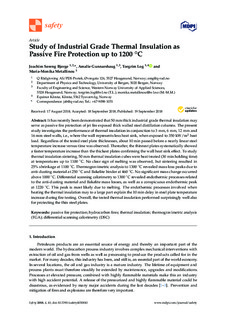| dc.contributor.author | Bjørge, Joachim Søreng | |
| dc.contributor.author | Gunnarshaug, Amalie | |
| dc.contributor.author | Log, Torgrim | |
| dc.contributor.author | Metallinou, Maria-Monika | |
| dc.date.accessioned | 2019-02-11T15:08:22Z | |
| dc.date.available | 2019-02-11T15:08:22Z | |
| dc.date.created | 2018-09-19T16:52:08Z | |
| dc.date.issued | 2018 | |
| dc.identifier.citation | Bjørge, J. S., Gunnarshaug, A., Log, T. & Metallinou, M.-M. (2018). Study of industrial grade thermal insulation as passive fire protection up to 1200 °C. Safety, 4(3), 1-19. | nb_NO |
| dc.identifier.issn | 2313-576X | |
| dc.identifier.uri | http://hdl.handle.net/11250/2584884 | |
| dc.description.abstract | It has recently been demonstrated that 50 mm thick industrial grade thermal insulation may serve as passive fire protection of jet fire exposed thick walled steel distillation columns. The present study investigates the performance of thermal insulation in conjunction to 3 mm, 6 mm, 12 mm and 16 mm steel walls, i.e., where the wall represents less heat sink, when exposed to 350 kW/m2 heat load. Regardless of the tested steel plate thicknesses, about 10 min passed before a nearly linear steel temperature increase versus time was observed. Thereafter, the thinnest plates systematically showed a faster temperature increase than the thickest plates confirming the wall heat sink effect. To study thermal insulation sintering, 50 mm thermal insulation cubes were heat treated (30 min holding time) at temperatures up to 1100 °C. No clear sign of melting was observed, but sintering resulted in 25% shrinkage at 1100 °C. Thermogravimetric analysis to 1300 °C revealed mass loss peaks due to anti-dusting material at 250 °C and Bakelite binder at 460 °C. No significant mass change occurred above 1000 °C. Differential scanning calorimetry to 1300 °C revealed endothermic processes related to the anti-dusting material and Bakelite mass losses, as well as a conspicuous endothermic peak at 1220 °C. This peak is most likely due to melting. The endothermic processes involved when heating the thermal insulation may to a large part explain the 10 min delay in steel plate temperature increase during fire testing. Overall, the tested thermal insulation performed surprisingly well also for protecting the thin steel plates. | nb_NO |
| dc.language.iso | eng | nb_NO |
| dc.rights | Navngivelse 4.0 Internasjonal | * |
| dc.rights.uri | http://creativecommons.org/licenses/by/4.0/deed.no | * |
| dc.subject | passive fire protection | nb_NO |
| dc.subject | hydrocarbon fires | nb_NO |
| dc.subject | thermal insulation | nb_NO |
| dc.subject | thermogravimetric analysis (TGA) | nb_NO |
| dc.subject | differential scanning calorimetry (DSC) | nb_NO |
| dc.title | Study of Industrial Grade Thermal Insulation as Passive Fire Protection up to 1200 °C | nb_NO |
| dc.type | Journal article | nb_NO |
| dc.type | Peer reviewed | nb_NO |
| dc.description.version | publishedVersion | nb_NO |
| dc.rights.holder | © 2018 by the authors. | nb_NO |
| dc.source.pagenumber | 18 | nb_NO |
| dc.source.volume | 4 | nb_NO |
| dc.source.journal | Safety | nb_NO |
| dc.source.issue | 3 | nb_NO |
| dc.identifier.doi | 10.3390/safety4030041 | |
| dc.identifier.cristin | 1611223 | |
| cristin.unitcode | 203,6,2,0 | |
| cristin.unitname | Avdeling for tekniske, økonomiske og maritime fag - Stord/Haugesund | |
| cristin.ispublished | true | |
| cristin.fulltext | original | |
| cristin.qualitycode | 1 | |

